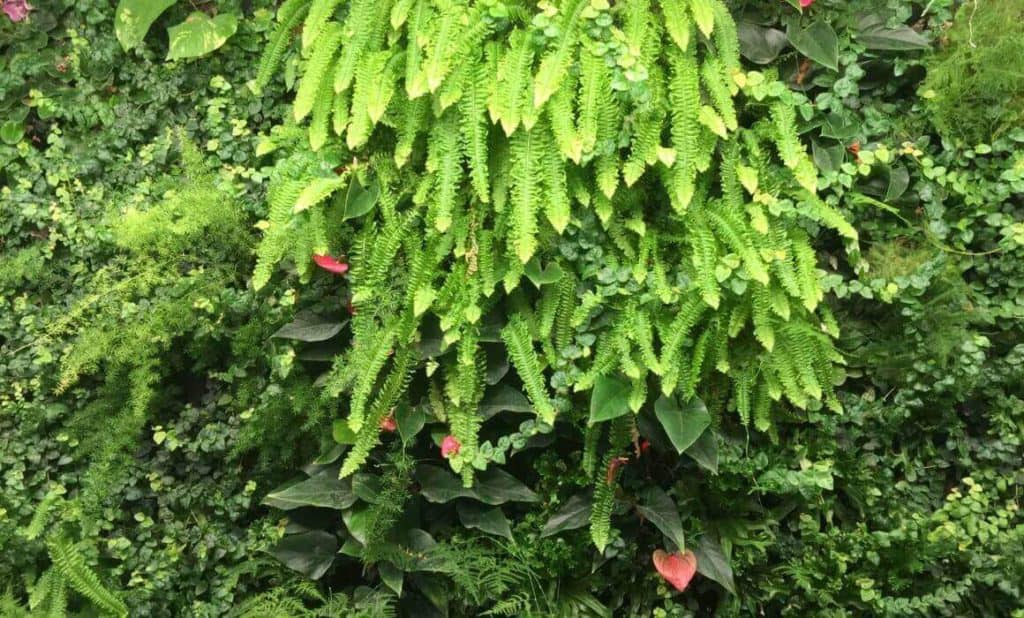As a Manhattan living wall installer we see a lot of apartments and they all share the same thing in common: they all have central heating and AC. This is nice because it keeps the apartments warm in the cold winters and cool in the hot muggy summers. However, that comes with a cost: low humidity, or better said, dry air.
Most New Yorkers know what I’m talking about. Dry skin, dry hair, dry sinuses. This can get especially bad in the winter and a lot of people have to get humidifiers. Not as well known is the fact that things get dry in the summer too. Maybe not outside where it can get humid. But AC’s are very effective at removing humidity. Often too effective, leaving the inside of the apartments with air that is too dry for the normal person.

Some heating systems are worse than others. Hot air heaters are the worst. They literally burn the humidity out of the air. Radiant flooring is better, but still they dry out the space. I have yet to see a NY apartment that isn’t too dry in the winter. In the summer if you have a little window AC then things aren’t so bad. They dehumidify but aren’t that strong. The central AC’s are another story. Most of them are too large for the space because on average NY apartments are smaller than national averages. And because of this they overly process the air and dry it out.
Dry air is a pain. It increases the dust particles in the air. It screws with your sinuses, blocking your nose and even increasing chances of getting a cold and allergies. Have you ever woken up in the middle of the night with a parched mouth and stuffy nose? Dry air. Dry, itchy skin? Dry air. Brittle hair with possibly even dandruff? Dry air. These problems are even worse for kids and elders who have more sensitive sinuses.
Enter the living wall. Living walls have plants and plants need water. The plants and soil let off water through evapotranspiration. More importantly, the water is fed from above and trickles down the living wall slowly, mixing the water with the air. Some of this water evaporates into the air. Essentially the living wall acts as a great humidifier. When the air is dry, the water on the living wall evaporates faster. When the air is not dry, the water evaporates more slowly.
Having a living wall in your Brooklyn or Manhattan home is a great way to help balance out the apartment’s humidity. No need to mess with an electric humidifier humming noisily in the background. The living wall does the humidification control naturally and quietly. No electricity needed.
As a local New York living wall installer we also deal with a lot of small and poorly ventilated apartments. It’s just the nature of many apartments. And thus the flip side – too much humidity – is also a concern for us. But we have found that living walls do not create overly humid environments. We have never had a client complain that the living wall made their home too humid. We believe this is because although a living wall does have plenty of water, it is very well drained. The water moves down the wall. If the air is super dry, then some of that water evaporates into the air. If the air isn’t dry then the water keeps on going down the wall and collects in the basin below the living wall or just goes down the drain.
We believe this is because although a living wall does have plenty of water, it is very well drained. The water moves down the wall. If the air is super dry, then some of that water evaporates into the air. If the air isn’t dry then the water keeps on going down the wall and collects in the basin below the living wall or just goes down the drain.
 You can’t say this about an electric humidifier. I don’t know if you’ve ever left a humidifier in a closed room, but it becomes a tropical rain forest in there. That is a problem. It’s the perfect environment for mold. The reason this problem occurs is that an electric humidifier pumps out humidity regardless of the room air humidity. Not so for a living wall. It lets off humidity as needed only.
You can’t say this about an electric humidifier. I don’t know if you’ve ever left a humidifier in a closed room, but it becomes a tropical rain forest in there. That is a problem. It’s the perfect environment for mold. The reason this problem occurs is that an electric humidifier pumps out humidity regardless of the room air humidity. Not so for a living wall. It lets off humidity as needed only.
So in short, living walls are great natural humidifiers without the issues of a noisy overly productive electric humidifier. And did we mention aesthetics? Living walls are beautiful. They nourish the soul. Electric humidifiers are ugly and get in the way, often ending up as junk in a closet.
So if you live in NY and have the money and space, get yourself a living wall. Your body will thank you for it. People don’t realize how much dry air negatively effects them. But once they install a living wall the difference is noticeable.

